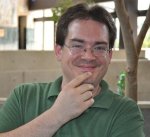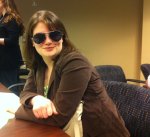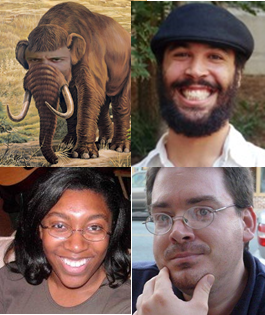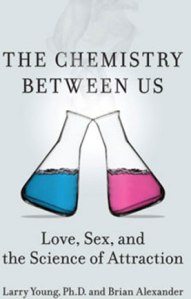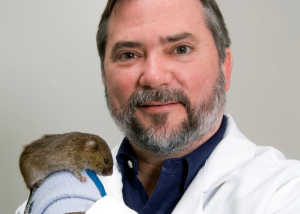By James Burkett
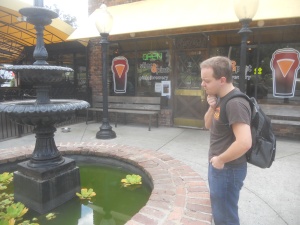
The recent closure of Everybody’s Pizza in the Emory Village has left a hole in some of our hearts – and all of our stomachs. Fortunately, the pizza-and-beer torch has now been passed to a new restaurant, which promises to surpass the old one in every way: The Slice and Pint.
Located in the same great spot on the Emory Village roundabout, the Slice and Pint has taken pizza and beer to a new level. First, the restaurant itself has been renovated to give it a warm, inviting feel while preserving the historical building’s old-fashioned charm. Reclaimed pecky cypress walls, a gorgeous copper bar top, and newly refinished wood floors and tables give the old place a sleek, fresh look. Even the bathrooms have been given a style upgrade worth checking out.
![DSCN3531[1]](https://thecentralsulcus.files.wordpress.com/2013/10/dscn35311.jpg?w=300&h=225)
![DSCN3530[1]](https://thecentralsulcus.files.wordpress.com/2013/10/dscn35301.jpg?w=300&h=225) However, the biggest upgrade is to the menu. The new owners are totally focused on high-quality, local organic ingredients – including mozzarella made fresh in-store, local meats and local seasonal veggies. The pizzas are made using handmade dough that uses the same beer yeast they plan to use in their brewing tanks, giving it a unique and pleasantly mild sourdough taste. Their red sauce is similarly unique, with a sweet and slightly spicy taste.
However, the biggest upgrade is to the menu. The new owners are totally focused on high-quality, local organic ingredients – including mozzarella made fresh in-store, local meats and local seasonal veggies. The pizzas are made using handmade dough that uses the same beer yeast they plan to use in their brewing tanks, giving it a unique and pleasantly mild sourdough taste. Their red sauce is similarly unique, with a sweet and slightly spicy taste.
The highlight of the menu is their collection of exceptional specialty pizzas, which are sized for two, making them a very good value. The swine pie is a favorite among all the guests I’ve brought: thick layers of cheese covering a delicious (though small) sampling of a North Carolina-style BBQ chicken. True carnivores might like the generous portions of meat on the Ultimate Pepperoni, or the delicious, high quality local sausage on the Riverview Farms sausage pizza. For the vegetarians among us, try the margherita to sample the house-made mozzarella, or the seasonal veggie pizza to see what they can do with whatever is growing fresh in the local area.
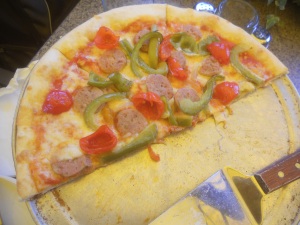
They have larger pizzas per-ingredient for groups, and loners can order big slices or try one of the focaccia-bread sandwiches (the caprese is my favorite). You can also order crispy calzones with any of their toppings and sauces (which are also sized for two, and I recommend sharing for an exceptional value). I have personally tried a BBQ chicken and a pesto chicken calzone, and both were amazing. One hidden gem on the menu that you shouldn’t miss is the tater tots. These cheese-infused tots are so good you will slap Ore Ida in the face. With one of the sandwiches, $1 upgrades your side item to the tots, which is pretty much the best dollar you will spend in your life. And I’m including the Georgia Mega Millions.
After a brief wait at the beginning of the semester, S&P now has their liquor license up and running. They have a smart and well-chosen selection of 15 craft beers on tap, including numerous brews from right here in Georgia. Plus, right next door, the space that used to be the Steady Hand (and before that, a series of coffee and tea shops) is being renovated to put in their own brewery tanks, where they plan to make some in-house brews.
The only potential pitfall in the otherwise exceptional menu is the appetizers. The appetizers are very tasty, and the tater tots are tiny balls of sweet heaven. However, the appetizer portions are a little small and may catch the unwary diner off-guard.
If you’re looking for your average, run-of-the-mill grease bomb pizza, there are two other pizza places within sight of the front door. What the Slice and Pint offers is a delicious, unique taste with high quality ingredients, served in a true brewpub atmosphere.
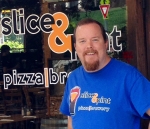
If you still need a reason to try it out, one of the new owners, Russ Yates, is an old friend of mine and a long-time home brewer. If you’re on a boring date here and short on conversation, call Russ or his partner over and ask them something about beer; they know more about brews than you know about neurons. I took advantage of our friendship to ask Russ a few questions.
Me: The old Everybody’s Pizza seemed to leave Emory Village very suddenly. What happened, and how did you come to take over their space?
Russ: The partners had a great run of almost 42 years and were just ready to retire. As one of the partners told me, he just wanted to spend some time on the beach with his grandkids. Hard to argue with that. My partner, Crawford Moran, was asked by the landlord if he would be interested in the location for a brewpub and it all took off from there.
Me: Tell us a bit about the partnership that brought us this restaurant.
Russ: I met Crawford while I was at my previous job contracting with Coca-Cola. I worked downtown at Coca-Cola headquarters for 8 years in their packaging group. Once the 5 Seasons Westside location opened up 4 years ago, I made a point to drop by every Thursday for the cask ale that Crawford would put on, and I got to know Crawford quite well over the years. I have always wanted to open a brewpub and I had talked to Crawford about it for some time as he has a wealth of knowledge pertaining to the business from his current and past experiences. Crawford and I got together and talked about the opportunity of taking over Everybody’s late last year and decided that it would be a great place to put a brewpub. The location is perfect with Emory across the street and Druid Hills all around it. Also, there isn’t another brewpub in the close vicinity, which would allow us to be THE local pub that we wanted to be for the area. Not to mention, pizza and beer just go great together. Coming from my customer focused on-site background at Coca-Cola, my focus is mainly on the front of house and making sure that all of our customers have the best experience they can possibly have. Crawford will focus on the brewery operations but I’m also looking forward to getting involved in that as well once we get the brew house up and running.
Me: What is it that makes your food unique?
Russ: We wanted to step up the average pizza offerings that many places have. First of all, we use all organic flour in our pizza dough and then we combine 2 Italian yeast strains, as well as our favorite Trappist beer yeast strain, to give it a great flavor that you will not find anywhere else. From there, we source many of our vegetables from local Georgia farms and source most of our meat from local butcher shops and other Georgia farms, including Riverview Farms and White Oak Pastures. The pepperoni we have from Heywood’s Meat Haus in Marietta is just awesome. It will ruin you for regular pepperoni. By using all of these ingredients, it makes for a better pizza that tastes better and is better for you. We will be changing up our menu on a regular basis to include the different fresh fruits and vegetables we get from our farmers.
Me: I understand you’re installing brewery tanks for making your own micro-brews. When will those be ready? Can you tell us a bit about what you will be brewing?
Russ: We are working on building out the brewery now and should have the equipment by next month. We are targeting pouring our fresh beer around the first of next year. As far as the beer goes, we will start with a Belgian golden that will use the same beer yeast strain that is in our pizza dough. We think that will really tie together the beer and pizza nicely. After that, we will have many other styles including IPA, Pale Ale, Porters and Stouts. We’ll also do a lot of seasonal beers to go along with the seasonal offerings we have on our menu. It’s fun to pair the various beer styles with our food.
Me: Out of the whole menu, what is your personal favorite?
Russ: It changes from time to time, but I’m a big fan of the Southern Pie. It has pimento cheese, fried green tomatoes and pork belly bits. We were trying to roll a classic southern dish into a pizza and it came out great. We liked it so much we even made a sandwich out of it. It’s our twist on a BLT sandwich.
Me: Are there any upcoming seasonal items that we can look forward to?
Russ: We changed up the Prosciutto & Peaches to Prosciutto & Figs, which people are loving. We just replaced our gazpacho with our chili for the fall, which uses White Oak Pasture’s grass fed beef and pinto beans. It’s perfect for the cooler days we are having now. We will also continue to change our specials menu from time to time, so always check there when you come to the pub. Our beer list will change on a regular basis too, as well as the house-made infusions we are using in our cocktails.
Me: Thank you very much, Russ!
Post your own comments and your experiences at the Slice and Pint in the comments section below. Or, if you have any questions for Russ, post them here and I might fire them off to him!
